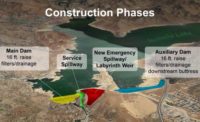A $1-billion upgrade to the B.F. Sisk Dam in California’s Central Valley was launched this month as part of an effort to reduce the impact of severe seismic events on the 55-year-old earthfill structure.
The 382-ft-high, 3.5-mile-long compacted earthfill embankment dam is owned by the U.S. Bureau of Reclamation (USBR). The Safety of Dams Modification Project will require adding stability berms, increasing the height of the existing dam and other safety enhancing features.
The dam, completed in 1967, impounds San Luis Reservoir, the nation’s largest offstream reservoir, which provides supplemental irrigation water storage and municipal and industrial water for the Central Valley and for California’s State Water Project.
“This investment in B.F. Sisk Dam, located south of the Sacramento-San Joaquin Delta, will build water supply security for California communities, farmers and ranchers and wildlife refuges, and help the system better adapt to a changing climate,” said Assistant Secretary for Water and Science Tanya Trujillo in a news release.
The safety modification project is the agency’s largest project under the 1978 Safety of Dams Act and is scheduled for completion in 2028.
In April, NW Construction of Bozeman, MT was awarded a $120 million contract for the first phase of work on the retrofit project. The work will address issues with foundation materials used on the dam as well as the construction of shear keys, stability berms and modifications to the spillway. A key challenge for the company will be developing, processing and transporting specified materials to the intended areas of placement from the rock quarry located more than three miles away.
“This will require extensive planning and execution to move the required amounts of materials safely and successfully to meet the schedule restrictions in the contract which are dictated by the varying reservoir levels,” says Casey Patterson, vice president and operations manager for NW Construction.
The project will take at least three construction contracts and between eight and 10 years to complete, says USBR Principal Deputy Regional Director Richard Welsh.
The project received a $100-million investment last March from the Infrastructure Investment and Jobs Act which was part of the $500 million awarded to the US Bureau of Reclamation over the next five years to support critical dam safety projects.
A series of seismic risk studies completed in 2006 found that the California dam’s foundation materials were insufficient to resist the impacts of a severe seismic event putting downstream public at risk in the event of a potential severe earthquake. The dam sit near several fault lines including the Ortigalita fault, which crosses San Luis Reservoir.
The project will also involve increasing the dam height by 12 ft, reducing the likelihood of water coming over the top of the structure if the embankment were to slide or slump during a seismic event. The additional dam height will create more than 130,000 acre feet of extra water storage in San Luis Reservoir.




Post a comment to this article
Report Abusive Comment